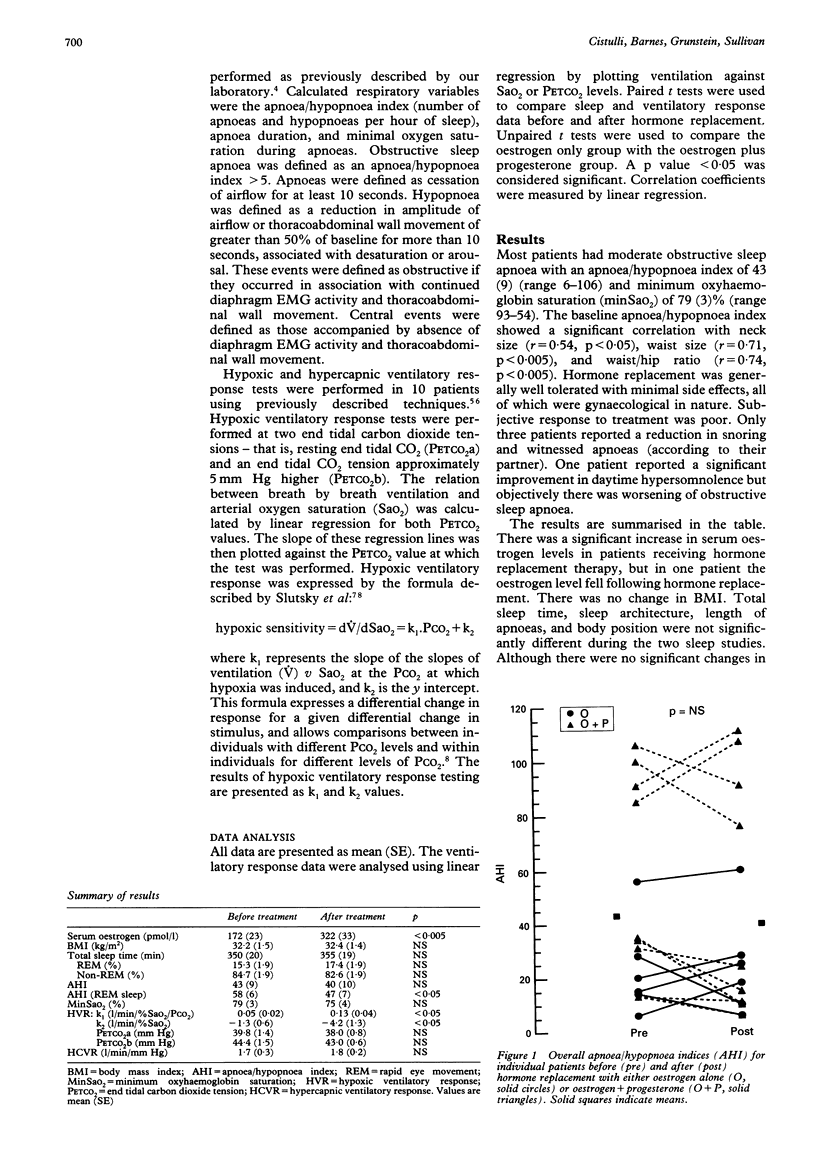Abstract
BACKGROUND--Women appear to be increasingly susceptible to snoring and sleep disordered breathing after the menopause. This observation, coupled with the considerable sex difference in sleep apnoea, may be explained on the basis of a protective effect of female hormones. This study was carried out to determine whether hormone replacement therapy has a role in the management of obstructive sleep apnoea in postmenopausal women. METHODS--The effect of short-term (mean (SE) 50 (3) days) hormone replacement therapy with either oestrogen alone or in combination with progesterone on sleep disordered breathing was investigated in 15 postmenopausal women with moderate obstructive sleep apnoea. The effect of treatment on the ventilatory response to hypoxia and hypercapnia was assessed in 10 patients. RESULTS--There was no reduction in the clinical severity of obstructive sleep apnoea after hormone treatment despite an increase in the serum oestrogen level from 172 (23) to 322 (33) pmol/l. There was a small but clinically insignificant reduction in the apnoea/hypopnoea index during REM sleep from 58 (6) to 47 (7). There was no difference in response between the oestrogen only group and the oestrogen plus progesterone group. Hypercapnic ventilatory responsiveness did not change with hormone treatment, but an change with hormone treatment, but an increase in hypoxic ventilatory responsiveness was observed. CONCLUSIONS--These data indicate that short-term hormone replacement is unlikely to have an effective role in the clinical management of postmenopausal women with obstructive sleep apnoea. The observed reduction in the apnoea/hypopnoea index during REM sleep, however, suggests that longer term treatment, or the use of higher doses, may have an effect.
Full text
PDF



Selected References
These references are in PubMed. This may not be the complete list of references from this article.
- Block A. J., Wynne J. W., Boysen P. G. Sleep-disordered breathing and nocturnal oxygen desaturation in postmenopausal women. Am J Med. 1980 Jul;69(1):75–79. doi: 10.1016/0002-9343(80)90502-1. [DOI] [PubMed] [Google Scholar]
- Cistulli P. A., Sullivan C. E. Sleep-disordered breathing in Marfan's syndrome. Am Rev Respir Dis. 1993 Mar;147(3):645–648. doi: 10.1164/ajrccm/147.3.645. [DOI] [PubMed] [Google Scholar]
- England S. J., Farhi L. E. Fluctuations in alveolar CO2 and in base excess during the menstrual cycle. Respir Physiol. 1976 Apr;26(2):157–161. doi: 10.1016/0034-5687(76)90093-1. [DOI] [PubMed] [Google Scholar]
- Franklin K., Lundgren R., Rabben T. Sleep apnoea syndrome treated with oestradiol and cyclic medroxyprogesterone. Lancet. 1991 Jul 27;338(8761):251–252. doi: 10.1016/0140-6736(91)90389-7. [DOI] [PubMed] [Google Scholar]
- GOODLAND R. L., REYNOLDS J. G., MCCOORD A. B., POMMERENKE W. T. Respiratory and electrolyte effects induced by estrogen and progesterone. Fertil Steril. 1953 Jul-Aug;4(4):300–317. doi: 10.1016/s0015-0282(16)31327-9. [DOI] [PubMed] [Google Scholar]
- Johnson M. W., Anch A. M., Remmers J. E. Induction of the obstructive sleep apnea syndrome in a woman by exogenous androgen administration. Am Rev Respir Dis. 1984 Jun;129(6):1023–1025. doi: 10.1164/arrd.1984.129.6.1023. [DOI] [PubMed] [Google Scholar]
- Lombard R. M., Jr, Zwillich C. W. Medical therapy of obstructive sleep apnea. Med Clin North Am. 1985 Nov;69(6):1317–1335. doi: 10.1016/s0025-7125(16)30989-0. [DOI] [PubMed] [Google Scholar]
- Lyons H. A., Huang C. T. Therapeutic use of progesterone in alveolar hypoventilation associated with obesity. Am J Med. 1968 Jun;44(6):881–888. doi: 10.1016/0002-9343(68)90088-0. [DOI] [PubMed] [Google Scholar]
- Morikawa T., Tanaka Y., Maruyama R., Nishibayashi Y., Honda Y. Comparison of two synthetic progesterones on ventilation in normal males: CMA vs. MPA. J Appl Physiol (1985) 1987 Oct;63(4):1610–1615. doi: 10.1152/jappl.1987.63.4.1610. [DOI] [PubMed] [Google Scholar]
- PROWSE C. M., GAENSLER E. A. RESPIRATORY AND ACID-BASE CHANGES DURING PREGNANCY. Anesthesiology. 1965 Jul-Aug;26:381–392. doi: 10.1097/00000542-196507000-00003. [DOI] [PubMed] [Google Scholar]
- Phillipson E. A., Sullivan C. E., Read D. J., Murphy E., Kozar L. F. Ventilatory and waking responses to hypoxia in sleeping dogs. J Appl Physiol Respir Environ Exerc Physiol. 1978 Apr;44(4):512–520. doi: 10.1152/jappl.1978.44.4.512. [DOI] [PubMed] [Google Scholar]
- Pickett C. K., Regensteiner J. G., Woodard W. D., Hagerman D. D., Weil J. V., Moore L. G. Progestin and estrogen reduce sleep-disordered breathing in postmenopausal women. J Appl Physiol (1985) 1989 Apr;66(4):1656–1661. doi: 10.1152/jappl.1989.66.4.1656. [DOI] [PubMed] [Google Scholar]
- Read D. J. A clinical method for assessing the ventilatory response to carbon dioxide. Australas Ann Med. 1967 Feb;16(1):20–32. doi: 10.1111/imj.1967.16.1.20. [DOI] [PubMed] [Google Scholar]
- Rebuck A. S., Campbell E. J. A clinical method for assessing the ventilatory response to hypoxia. Am Rev Respir Dis. 1974 Mar;109(3):345–350. doi: 10.1164/arrd.1974.109.3.345. [DOI] [PubMed] [Google Scholar]
- Zwillich C. W., Natalino M. R., Sutton F. D., Weil J. V. Effects of progesterone on chemosensitivity in normal men. J Lab Clin Med. 1978 Aug;92(2):262–269. [PubMed] [Google Scholar]


